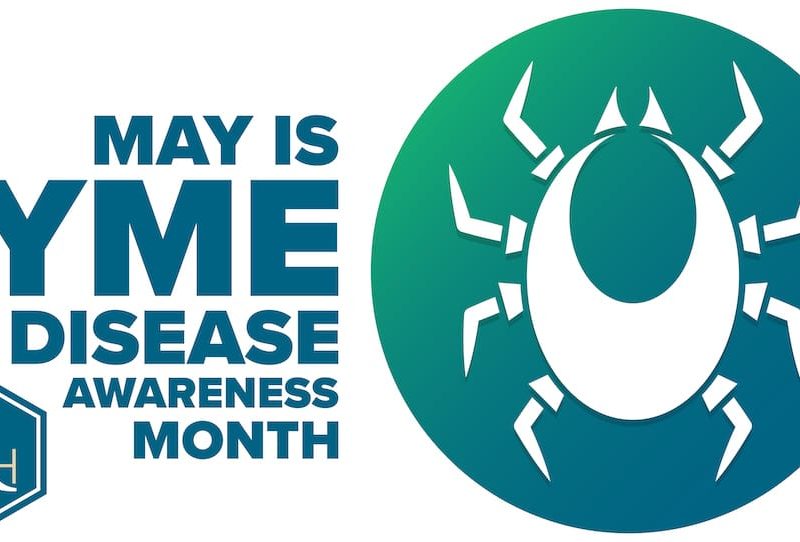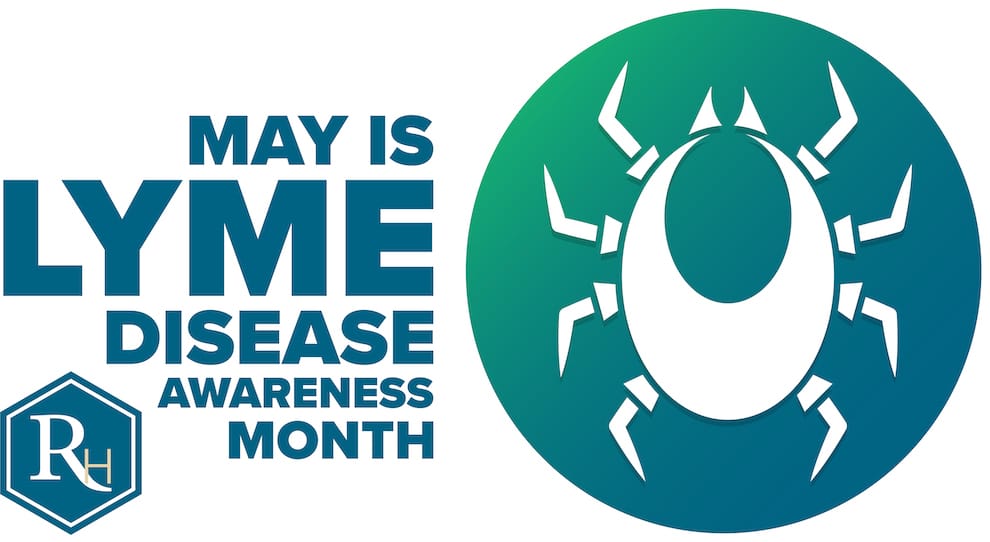The Latest Lyme Disease News and Research

May is Lyme Disease Awareness Month, and here at the Restoration Healthcare, this is a special month for us. Our medical director, Dr. Raleigh, is widely recognized by patients and referring physicians from across the country as among the top Lyme doctors in Southern California.
Dr. Raleigh keeps abreast of the latest news and research on a broad scope of health issues, but she has a special interest in Lyme disease. So, we’re kicking off the month of May with the latest Lyme disease news and research that we find most intriguing.
But first, for anyone who believes they may have been bitten by a tick, we present a brief introduction to Lyme disease.
What Is Lyme Disease?
Lyme disease is the most common vector-borne disease in the United States. A vector is an organism, such as an insect, that transmits an infectious virus, bacteria, or parasite. In the case of Lyme disease, the vector is the notorious black-legged deer tick, and the infectious bacteria are Borrelia burgdorferi.
Symptoms of Lyme disease are typically broken down into early signs (three to 30 days after being bitten) and longer term (days to months after being bitten):
Early symptoms:
- Fever
- Chills
- Headache
- Fatigue
- Muscle and joint aches
- Swollen lymph nodes
- Erythema migrans (EM) “bulls-eye” rash around the site of the bite, in about 70 to 80 percent of cases
Late symptoms:
- Severe headaches
- Stiff neck
- EM rashes on other areas of the body
- Facial palsy
- Fatigue
- Arthritis with severe joint pain and swelling, particularly the knees and other large joints
- Intermittent pain in tendons, muscles, joints, and bones
- Heart palpitations or an irregular heartbeat (Lyme carditis)
- Episodes of dizziness or shortness of breath
- Inflammation of the brain and spinal cord
- Nerve pain
- Shooting pains, numbness, or tingling in the hands or feet
Traditional treatment for Lyme disease typically calls for antibiotics over the course of at least 30 days, but even after the initial infection clears, symptoms can linger for years. Here at Restoration Healthcare, we offer personalized treatment plans that can give your body what it needs to win the battle against this tenacious and often debilitating disease.
With that as our backdrop, here are six Lyme disease-related updates that are worth noting as we enter Lyme Disease Awareness Month:
A New Test for Diagnosing Lyme Disease
Lyme disease is challenging to diagnose. Tests are available, but many patients test negative for antibodies to the bacteria that causes it. Having consistently accurate test results would help significantly with early diagnosis and to determine the effectiveness of treatments.
Researchers at Tufts University School of Medicine may have discovered a more accurate mechanism to test infected individuals that detects an antibody produced in response to a growth substance that the bacteria acquire from infected tissues or organs. This test claims in could, “provide clinicians with a way to diagnose the disease sooner, know whether treatment with antibiotics is working, and identify patients who have been reinfected.”
Peter Gwynne, Ph.D., a microbiologist at Tufts University is raising $1 million to continue work on developing the test and hopes to see it become commercially available within a few years.
Climate Change and the Increasing Prevalence of Lyme Disease
According to the Proceedings of the National Academy of Sciences, climate change is hastening the spread of infectious diseases, including Lyme disease. Here in Southern California, tick season lasts pretty much the entire year. In colder climates, that period is typically restricted to the spring and summer — or at least it used to be. Climate change is extending the zones in which troublesome ticks can live and shortening winters, so that they can remain active longer.
That means that if you live in an area where black-legged ticks reside, don’t assume you’re safe walking through the woods on a winter day.
New Tick Borne “Heartland” Virus
Although Lyme Disease and Rocky Mountain Spotted Fever seem to capture most of the headlines related to tick-borne diseases, the Centers for Disease Control and Prevention (CDC) currently recognizes 18 tick-borne diseases in the United States. One of the newest is caused by the so-called Heartland virus.
First identified in Missouri in 2009, a new strain of the virus has recently been discovered in Georgia, providing evidence that it is spreading and mutating. No formal testing or treatment is available, and the level of transmission to humans is unknown.
Learn more on the CDC’s Heartland Virus page.
Inaccurate Lyme Disease Testing Revealed
Patient-centered advocacy organization TruthCures recently presented evidence to Food and Drug Administration (FDA) officials and the Massachusetts Board of Registration in Medicine (Mass BORIM) to explain how the Lyme disease diagnostic method was manipulated starting in 1995 resulting in the development of notoriously inaccurate Lyme disease diagnostic tests.
TruthCures claims that the diagnostic tests are inadequate because they detect only a small minority of cases predisposed to developing “Lyme arthritis,” a less-severe manifestation of the disease. In more severe cases, the bacteria suppress the immune system resulting in false negatives based on the criteria that have been in place for nearly three decades.
Lyme Disease Ticks on California Beaches?
If you thought you could steer clear of ticks by hanging out at the beach, think again, according to an NPR report, “Lyme disease-carrying ticks are turning up on California’s beaches.”
According to a four-year study out of Colorado State University in Fort Collins, ticks, which have traditionally resided in wooded areas and tall grass, were found on Northern California beaches, from Monterey County up to Mendocino County. And they seem to be moving farther south, including to Newport Beach.
Learn more by reading about the Bay Area Tick Study.
The Invisible Kingdom: Reimagining Chronic Illness
 Meghan O’Rourke suffers from Lyme disease and from a healthcare system that’s poorly equipped to diagnose and treat chronic illnesses like Lyme. In her book The Invisible Kingdom: Reimagining Chronic Illness, she shares her story and what she has learned through her search for effective treatment.
Meghan O’Rourke suffers from Lyme disease and from a healthcare system that’s poorly equipped to diagnose and treat chronic illnesses like Lyme. In her book The Invisible Kingdom: Reimagining Chronic Illness, she shares her story and what she has learned through her search for effective treatment.
Meghan’s book is an important reminder that conventional medicine is effective in treating acute conditions and providing some temporary symptomatic relief. What it doesn’t do is uncover and treat the root causes of chronic illnesses, such as arthritis, asthma, autism, cancer, Crohn’s, chronic obstructive pulmonary disease (COPD), depression, diabetes, heart disease, hypertension, kidney disease, Lyme disease, and type 2 diabetes.
You can learn more about Meghan by visiting her Facebook page.
If you’re suffering from an unexplained and undiagnosed health condition or you have a constellation of symptoms that defy a single, simple diagnosis, regardless of whether it’s linked to Lyme disease, we encourage you to read The Invisible Kingdom. More important, we urge you to seek treatment through a functional and integrative medical practice. If you are in or near Irvine, California, visit our website — RhealthC.com — where you can watch videos featuring our patients and request a new patient packet.
————
Disclaimer: The information in this blog post about Lyme disease is provided for general informational purposes only and may not reflect current medical thinking or practices. No information contained in this post should be construed as medical advice from the medical staff at Restoration Healthcare, Inc., nor is this post intended to be a substitute for medical counsel on any subject matter. No reader of this post should act or refrain from acting on the basis of any information included in, or accessible through, this post without seeking the appropriate medical advice on the particular facts and circumstances at issue from a licensed medical professional in the recipient’s state, country or other appropriate licensing jurisdiction.


